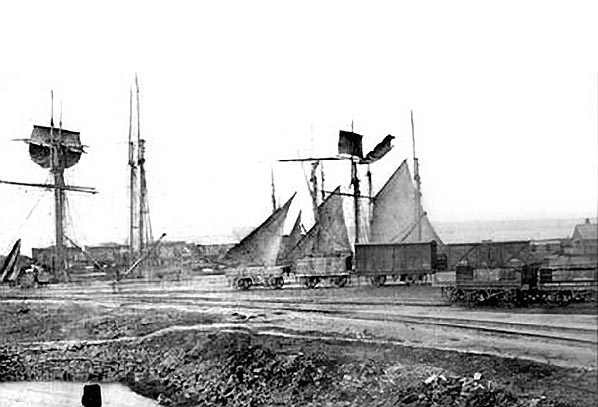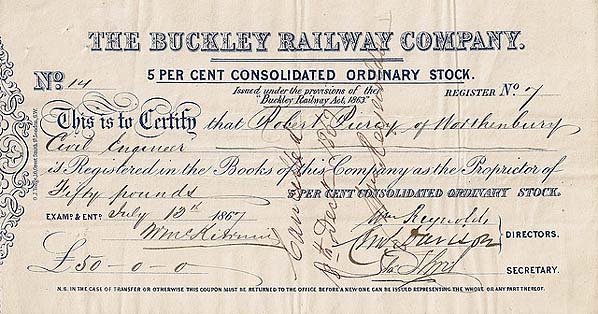
BUCKLEY RAILWAY[Source:
Paul Wright]
The Buckley Railway was 5 miles in length and ran from Connah’s Quay on the banks of the River Dee to Mountain Colliery near Buckley which lay in the Parish of Hawarden. The line was authorised on the 14th of June 1860 and opened for goods services only on the 7th of June 1862.  1952 1" OS map showing the course of the Buckley Railway
The line was promoted by a number of businessmen from the area who wanted a railway connection to their various collieries and brickworks so that they might better take their products to market. The area had been served by tramroads since the 1750s but by the 1850s they were an outdated mode of transport and the British Isles had already seen the first wave of a massive railway building programme which had seen most of the industrial areas connected up. At Connah’s Quay the Chester and Holyhead Railway which was by the 1850s part of the London & North Western Railway (LNWR), ran along the coast and served the towns along its route well. The Buckley area though did not have this advantage. It was also difficult terrain over which to transport goods being at a high elevation.
The engineer appointed to construct the line was George Bellis of Mold. At its southern end it started at Knowle Lane Brickworks and then ran via Northop Hall Village down to Connah’s Quay. At Connah’s Quay the line forked giving a connection with the LNWR just to the west of that companies Connah’s Quay station and providing a direct link to the Quay itself. The line was single track and very steeply graded having gradients of 1/30, 1/33 for half a mile, 1/38 and 1/40. It was also lightly laid as there was no intention of introducing passenger services.
The line provided links to a number of brickworks including the Old Ewloe Hall Brickworks, the Globe Brickworks, Knowl Hill Brickworks and the Standard Tile & Brickwork Company, the line also served the Buckley Gas Works and Thomas John Shone Boilermakers. Collieries served by the line included Mount Pleasant, Little Mountain, Cheapside, Drury and Mountain. Bricks from the Buckley area were transported to places as far away as the United States. 
1899 1:2,500 OS Map showing the Buckley Railway at Connah's Quay
At the time of opening the Buckley Railway had two locomotives and two brake vans. It owned no wagons as the industries themselves were expected to provide them. Services operated down to Connah’s Quay where they went onward via the LNWR or by ship from the Quay. Far more goods went onward by sea though. Within a few years of opening the line had become very busy and improvements such as the construction of passing loops had to be undertaken.
railway_old1.jpg)
Looking northwards along the fork of the Buckley Railway that connected to the LNWR Chester and Holyhead line at Connah's Quay. Behind the photographer was the junction with the line that proceeded directly to the Quay. It passed to the right out of view.
Copyright photo from John Alsop collection An Act of May 1866 allowed the WM&CQR to rent the Buckley Railway for a fee of £872 annually. In 1873 it was leased to the WM&CQR for 999. After the 1866 act was passed the WM&CQR worked the trains on the Buckley Railway and it effectively became part of their network although it was still nominally independent and would remain so until it was taken over by the Great Central Railway (GCR) in 1905 (as was the WM&CQR). In July 1875 a new dock opened at Connah’s Quay such was the level of traffic. railway3.jpg) Looking south along the course of the Buckley Railway from a point a few hundred metres to the north of Buckley Station in 1966 after the track had just been lifted. Drury brick works is seen on the left.
The Buckley Railway continued to provide a link to Connah’s Quay for the local industries along its route and a through route for the WM&CQR until the 29th of March 1890. On that day the WM&CQR opened the Hawarden Loop a new line that linked Connah’s Quay to the WM&CQR via Hawarden and which had easier gradients and double track. At Shotton it made an end on connection with the Manchester, Sheffield & Lincolnshire Railway’s (from 1897 the GCR) Chester to Hawarden Bridge line. There was also a branch from Shotton to Connah's’s Quay that was also double track. Most trains now used the new route leaving the Buckley Railway to handle only local traffic. railway2.jpg) Looking south along the course of the Buckley Railway towards Drury brickworks in 1966 after the track had just been lifted. Drury brick works is seen on the left.
On the 1st of January 1905 the Buckley Railway became part of the GCR. The line passed to the London North Eastern Railway (LNER) in 1923. Over the course of the 20th century many of the works along the route of the Buckley Railway closed. The last Colliery, the Mountain Colliery closed in 1930. By the time of nationalisation in 1948 the line was in terminal decline. In 1959 the section from Northop Hall to Connah’s Quay closed. From the 10th of September 1962 services over the remaining portion of the Buckley Railway were reduced to one trip per day which ran from Croes Newydd in Wrexham to Northop Hall. On the 5th of July 1965 the final section of the line closed completely and was lifted the following year. railway1.jpg)
Looking north towards Drury brickworks from Drury Lane bridge along the trackbed in April 1980. Buckley station was on the south side of the bridge.
Photo by John Mann Since closure the route of the line has been obliterated along most of its route. Sections of embankment and cutting still survive in places as do remain of bridges. At Connah’s Quay a short section of the line has been converted into a footpath and cycleway. The 1890 branch from the Hawarden Loop to Connah’s Quay was last used on the 1st of April 1967 and was officially closed on the 4th of September that year. A DVD of the Buckley Railway is available from the Buckley Society Source:
What remains of the Buckley Railway today (All April 2011 unless stated)
|


shed.jpg)
















 Home Page
Home Page